
Hi! Welcome to Probability Fall 2020!

In this post, I want to cover the usual “first day of class” topics. I’ll talk about the setup of the class. I’ll outline the topics and goals. All of this is covered more formally in the syllabus, which you should read at some point. Here, I’ll talk about the structure of the class more informally.
There are some parts of the class I want to decide about collectively with all of you; I’ll talk about that at the end.
The main home of the class is https://mcintyre.bennington.edu/probability/; I will put all the links to everything there.
First of all, welcome!
To start with, welcome back to Bennington! (In person or virtually!) This has been a very strange situation, and I’m sure many of you have had a very stressful and/or weird spring and summer. I want to acknowledge that, and build it in to my teaching this term—more on that at the end.
I’m glad to be back! It was difficult to suddenly switch to remote learning in the Spring, part way through the term. I’m hoping that remote/hybrid learning will work better now that I have had some time to plan and prepare.
I’m optimistic for this class, and excited to be teaching probability! It’s probably the standard math topic I know least well, and I’ve never taught it before. It’s an interesting subject, and I’m looking forward to getting started!
Organization of the class
My idea for the organization of the class is to have five main elements:
- Written lectures, in a “blog” format (like this one). These will be informal and conversational. A lot of what I will be doing is giving you a guide to reading the text. I will ask questions in these lectures, which I want you to try to answer. I will not be collecting your work on these questions. You should aim to read the written lecture, and at least try all the problems, before the class time, if you can.
- Synchronous video lectures. These will happen during the scheduled course time, but they won’t take up the whole time. Probably they will be about two or three hours per week total. These will support the written lectures. The video lectures may have more explanation, but they will not add anything new. In the video lectures, I will answer questions about the written lectures and the reading. The video lectures will also be recorded so you can watch them later. After the video lecture and class, you will probably find it necessary to go back and work through the written lecture a second time (at least).
- Synchronous individual and group meetings and work. Most of the scheduled course time, I will not be lecturing; you will be working, either individually or in groups, and/or I will be meeting with you, either individually or in groups. We will work together to figure out the most efficient use of class time, to help you work through the material. I’m thinking that we will start each class meeting with an hour of you doing reading and work, and with me available on Zoom; a break; then an hour of more formal lecture/class discussion; another break; then another hour of you working and me available again.
- Asynchronous discussion and meetings. It can be difficult to have a good class discussion on Zoom. I am hoping that Slack will be a replacement for that. In the #probability channels, you can post questions to the whole class and me, as well as thoughts about the material, interesting links, etc. You can also send me individual direct messages with questions, which only I will see. I am planning to do a lot of answering questions, and feedback on assignments, through Slack. I can also switch from text to video on Slack, if you want to discuss something that is difficult to do over text.
- Formal assignments. Once you have worked through the written lecture, and have done the problems there, you should work on the problems on the formal assignment. I will ask you to write up these answers fairly carefully. They should be written up clearly enough that someone who did not know the problem would be able to learn how to do it from your solution. I will have you submit your solutions to the assignments on a Google Drive folder, which will be shared between you and me only.
The text
The main element of this class is the textbook,
- William Feller, An Introduction to Probability Theory and its Applications, third edition, corrected printing, John Wiley & Sons 1970.
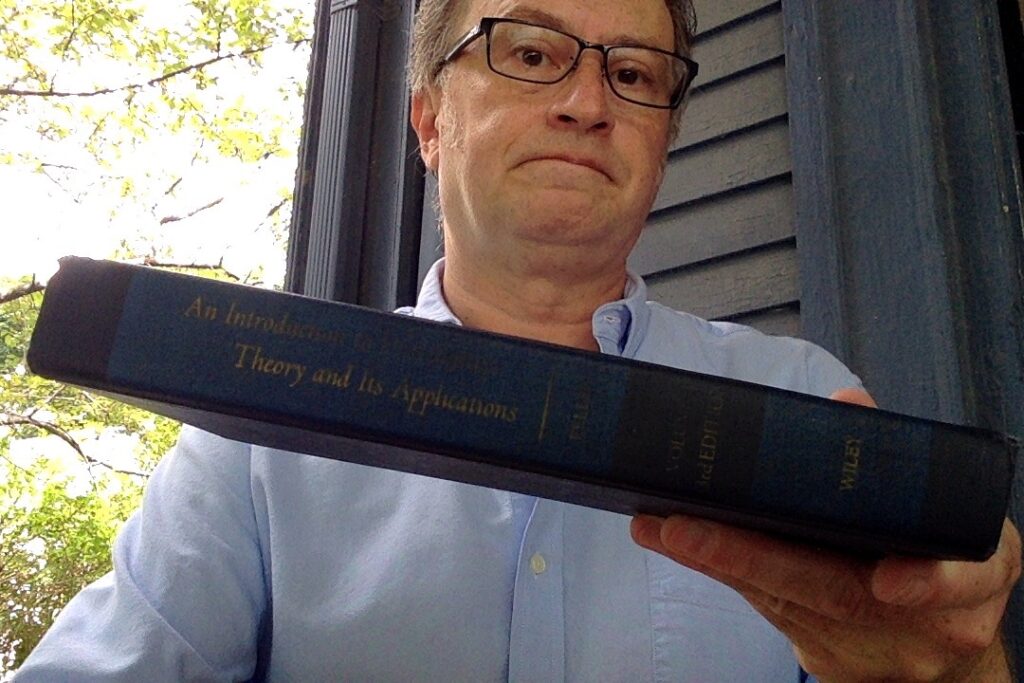
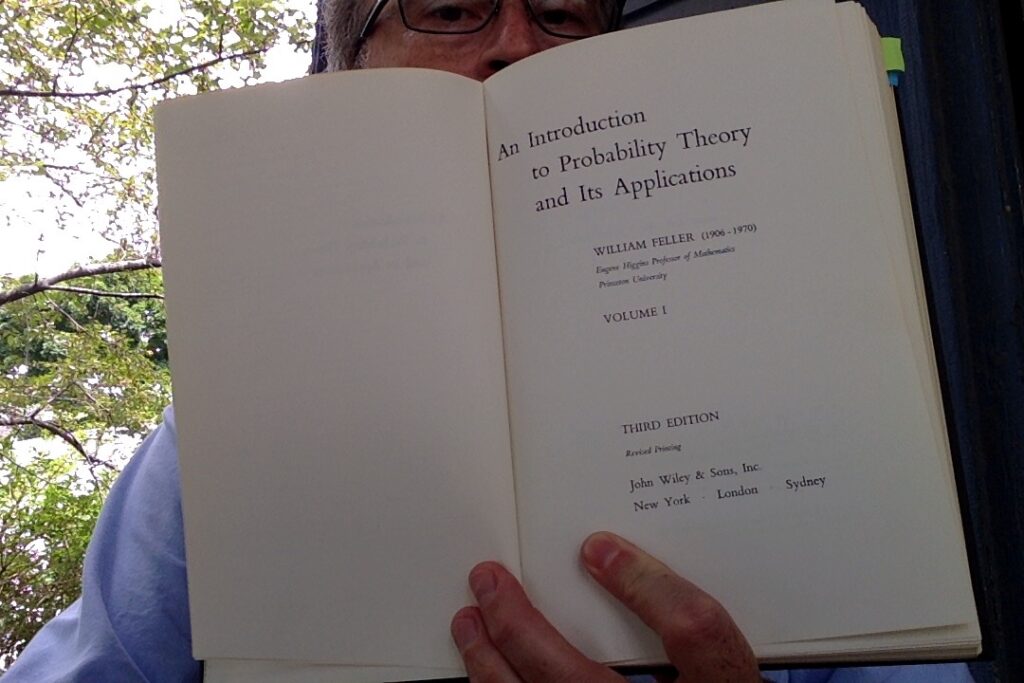
I apologize for the very high price of this book. Here is a link to a pdf. Print is nicer, of course; you can sometimes find reasonably priced used copies of this book. Try AbeBooks or alibris. (Be sure to get the corrected third edition; the other editions are quite different.)
Why did I choose such an old and expensive book? This book is a classic, and rightly so. It was the first comprehensive introduction to the subject in English, written by one of the masters of the subject. I spent a long time looking at all the probability books I could find, and none of them was as clear, as deep, or as interesting as this one.
The book is slightly old-fashioned in certain respects. In particular, there are two newer topics, that go by the names of “maximum likelihood” and “Bayesian probability”, that are not much covered in the book and are popular now (partly due to an increase in available computing power). My logic was that it would be better to get a solid grounding in the classical theory first, which this book provides. If you have that, the newer topics will not be difficult to pick up as you need them.
Also in that respect, I am sticking to problems that are done by pencil and paper, or at most a calculator. Some modern books do a lot of computer simulations. I am intentionally NOT doing that in this class. I think the computer approach makes sense, and has some definite advantages. However, overall, I think it is better to have a solid conceptual understanding first, and then to go to computer simulations later as needed.
(If you would like an alternate reference book, I would recommend the free book by Grinstead and Snell. It is pretty good, more modern, and close in structure to our class. Sometimes it can be helpful just to see an explanation in different words. It also describes a number of computer simulations which you can try out if you are interested.)
Specific goals of the class
I am planning this class as a classical, thorough introduction to the concepts of probability. The specific topics I’m planning are:
- Chapter I: Sample Spaces
- Chapter V: Conditional Probability and Independence
- Chapter VI: The Binomial and Poisson Distributions
- Chapter VII and X: The Normal Distribution and the Central Limit Theorem
- Chapter IX: Random Variables and Expectation
- Chapter III and XIV: Fluctuations in Coin Tossing and Random Walks
- Chapter XV: Markov Chains
Of course, these titles won’t make much sense until we get to them! For now, I would just say that these are standard, foundational topics, and that they should leave you well-prepared for using probability theory in future (including for the Machine Learning class in Spring, if you are planning to take that).
Note that the book contains a LOT more material than we will be able to cover. Part of my intention of assigning this book was so you could get used to it; then, if you want to learn about any of the many other topics covered in the book, you will already be familiar with the style and structure.
In each lecture and assignment, I will try to identify the main concepts and skills that I am trying to get you comfortable with.
More general goals
Because the textbook is so good, I want to use it a lot in this class. On a more general level, I am hoping that this class will help you build up or improve your skill at reading this sort of mathematical text. That way, when you need to learn more probability (or other math) in future, you will have an easier time doing so independently.
To that end, I am NOT going to explain all topics in the lectures. Instead, the lectures will be a guide to reading the text. I will try to prepare you for the reading, and I will try to provide additional explanation where needed; but I will try NOT to straightforwardly repeat what is already said in the text.
Also, this subject will provide interesting applications to things you may have seen in a more theoretical form in Logic and Proofs or Calculus (if you took those classes). Overall, I hope that you will leave this class with improved general mathematical skills, conceptual flexibility, and confidence!
Why I’m not going to cover current topics
Trigger warning (for this section only): illness, racism, other stressful topics…
Originally, when I was first planning this course earlier in the summer, I was thinking of MANY applications of this material to current events. There are natural connections of the probability theory we are learning to the coronavirus pandemic (testing, false positives and negatives, predicting true rates from testing rates…), to racism (inequality and police violence, analyzing other structural inequalities…), to politics (voter suppression, gerrymandering,…).
This seemed like a good opportunity, and I was planning many examples.
Then I did some reading on trauma and education, by people who have thought about this stuff a lot and have done a lot of research, and it changed my mind.
For some of us—for some of you—these issues are, or are going to be, not just abstract, but painfully personal. This would be true any time, and is particularly true this year. Maybe a family member is sick, or imprisoned, or something worse. If that is the case for you, then seeing examples like this in class is going to remind you of your trauma or stress, just at the moment when you are trying to forget it and concentrate on your work. If you have a lot going on, probably it is going to be hard to stay focused on your work anyway; I don’t want to make it harder.
I’ve given this a lot of thought, and I think that, while it would be interesting to cover current topics such as these, the potential for harm is just too great.
For that reason, I promise to keep all the examples neutral: cards and dice and such. When there is a somewhat current topic, I’ll keep it as neutral as possible. (For example, false positives and false negatives for disease tests is a standard probability example; I’ll keep it as nondescript as possible.)
I’ll set things up so that, if you are interested, it should be clear how to apply the ideas to current topics (and you can think of doing so as an optional exercise!). If you would like to talk about examples relevant to current topics, I’m happy to discuss them with you privately (you can direct message me in Slack).
Like with the computer stuff, I will try to provide you with the foundations, so that if you want to go on to apply these ideas yourself, you have all the tools to do so.
I hope that all makes sense!
Work expected
The workload for this class will be 20 hours per week, including the 8 hours of scheduled synchronous time.
I will probably end up assigning more work than is really feasible to do in this time limit. That is OK. If you are spending 20 hours per week, that is both sufficient and necessary to do well in the class. You should submit whatever work you have, including partial answers or ideas (more on that below).
Rather than thinking about a to-do list of readings and assignments, I would recommend just blocking out 20 hours per week in your schedule. This could be 4 hours each weekday (including our class times on Tuesdays and Fridays), with weekends off, or you could arrange it differently. During that time, do as much as you can on the work for this class.
It does need to be 20 actual hours, not half-attention shared with internet browsing and so on. This is really tough: it’s a lot of time to concentrate on math, and it takes practice. If you can’t keep it up in one session, don’t worry, just resolve to keep your time block tomorrow.
Keeping a record of your work
I recommend keeping your work in a journal format. Get a bound notebook (like a composition book). Write all your work in there, in chronological order: notes on classes, notes to yourself, work on exercises and assignments, examples you are making up.
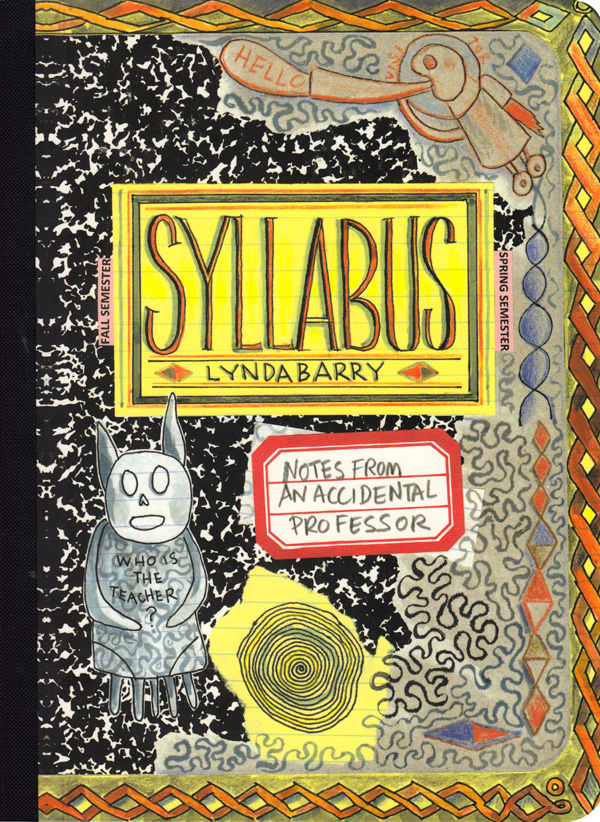
The notes to yourself are particularly important. This will help you in your thinking, and it will help me to see what you are thinking. You can write things like “I am confused about this question; how is it different from xxx?”, or “I think I need to apply the binomial theorem, but I’m not sure which variable is which”, and so on.
Here’s an example of journal-style notebook keeping. These examples are from Dan Quillen, a mathematician; you can see them here. You’re not going to understand the content, but I want to point out the style. Every page is numbered—I find this really helps with organization, even if you don’t use the page numbers much. The notebook starts with a table of contents:
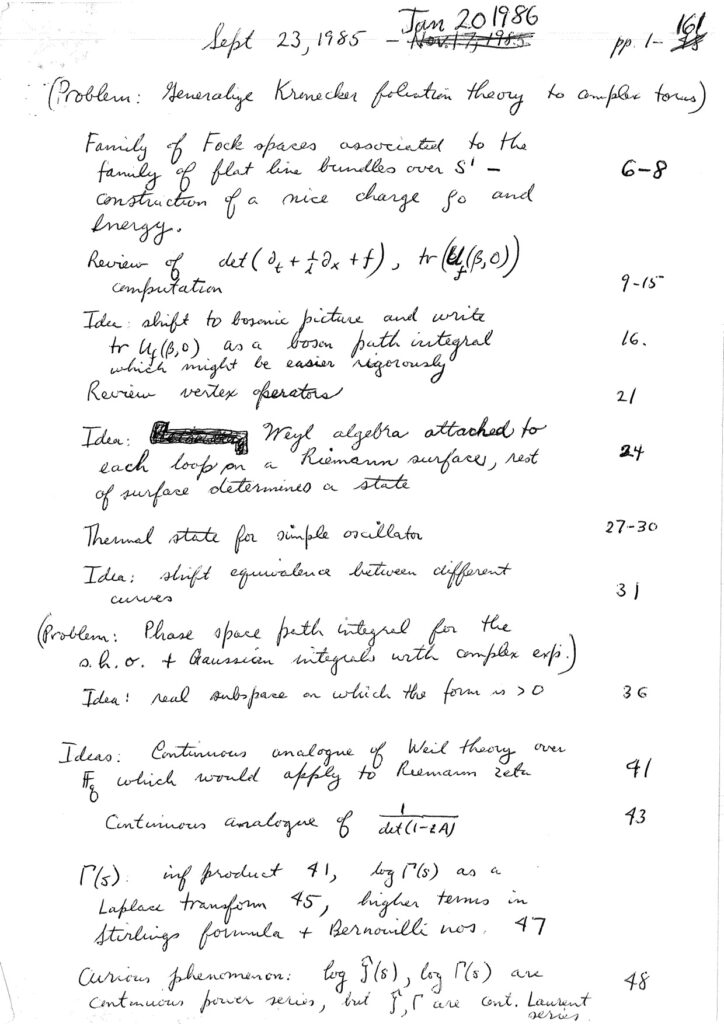
Here is a sample page. Don’t worry about the content. Note that the style is of talking to oneself. Note in particular: “What I am looking at is…”, and “The problem I am having is…”
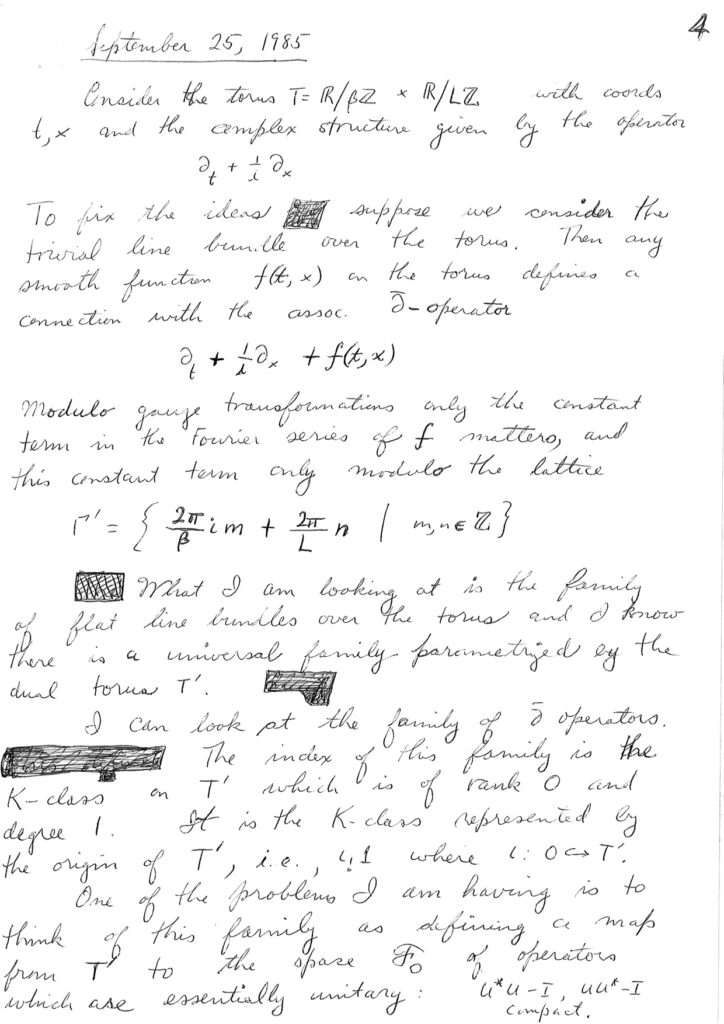
You don’t HAVE to keep your notes this way. You can organize them differently if you like, whatever makes the most sense to you. However you do it, you should make sure that it is easy for both you and me to see what you’ve done, to understand what you’ve done (even later after you’ve forgotten the set-up), and to find what you’ve done.
How to submit work
I will be creating a Google Drive folder for each of you. This folder will be shared between you and me only. All your work will be submitted in this folder.
Please use a pdf scanning app on your phone. There are several free ones available. This will align and filter the work to make it more legible, and it will create multiple-page pdfs. It can be quite difficult to read your work in photos, which are often upside-down or misaligned, in varying resolution, and only come one page at a time.
I recommend just updating the work you have on a regular schedule, whether or not assignments and other work are completed. The “journal” format of keeping notes and work functions well with this: just keep updating new pages of your journal/notebook as you have them.
If it isn’t obvious from your notes and work, you should make a note of time you spent, so that I know about it. For example, if you spent a long time reading the text, but don’t have notes on it you want to upload, or if you spent a long time explaining material to another student, these are things that are helpful for me to know. If you are keeping a journal format, you can just write those as “diary” entries: e.g. “Tuesday Sep 8, spent 2 hours working with group, mostly on beginning Chapter I questions, not much written down but understand the questions better now”—that kind of thing.
It’s more important for me to see your steady progress on the work, than to see completed assignments as full units. (Though you should aim to complete the assignments if possible!) I will have suggested due dates for exercises and assignments, but if you don’t get something done one week, you can submit it the next.
Feedback
![Comic with parent and child.
Parent: "What is causing distress"
Child: "I just wish to be a grown being so I can commit errors without my instructor marking them"
Parent: "This is unpleasant. And it is true I commit errors and no being marks them. Then other beings who need my precision commit errors and the cumulative consequences of my error expand beyond comprehension"
Parent: "It is terrifying to escape scrutiny"
[Parent stares into space]](https://mcintyre.bennington.edu/wp-content/uploads/2020/09/nathan-pyle-scrutiny-1.png)
Once a week, I will be looking at the work you have uploaded, checking it, and giving you feedback.
The feedback will mostly be a narrative paragraph, which I will send you on Slack (visible only to you).
Many of the questions either have the final answers given, or can be cross-checked in various ways, so for the most part you will be able to check whether your work is correct. I will check some for correctness, but mostly I will be looking at bigger issues. For example:
- Do you need to be writing more detail in your solutions, at least some of them? If you just have some numbers without explanation, I may not be able to see your reasoning and tell if you are understanding.
- On the other hand, maybe you are writing too much for every question, and having trouble getting through everything; if that seems to be the case, I will let you know that you can be more brief.
- If you are getting stuck on particular things, I can make suggestions about what you need to work on more.
- If you are getting hung up on a particular reading or assignment, I might suggest moving forward and then coming back as needed.
- If you’re having trouble getting a sufficient amount of work done, I’ll ask you about what is causing trouble, and we can work on a solution.
I think I will be setting a particular day of the week to do this: maybe Wednesdays? I will let you know.
You are encouraged to respond to my feedback as needed, and ask follow-up questions or make additions.
Support
Please ask questions! There will be time to do so in class. You can also write me in Slack any time. You can ask particular questions about particular problems (“am I doing this right?”, “how do I get started, I’m stuck”), or more general questions.
If you are comfortable doing so, I recommend asking questions in class, or posting questions to the Slack channels, so the rest of the class can either see my responses, or provide their own responses.
I also strongly encourage you to help each other in this class. I see the success of this class as being a group project: I want ALL of us to work towards ALL of us understanding this material. There is no “curve”: helping someone else will not hurt your standing.
In particular, if you are helping others, I would like to credit you for this on evaluations. So if you have been helping others, please make a note of it in your submitted work or on Slack. And if others have been helping you, please let me know that too, so I can credit them appropriately!
(“Helping” of course doesn’t mean doing other people’s problems for them, or giving them the answers. That doesn’t truly help in the long term anyway. It means discussing, making suggestions, providing hints, and talking through the concepts.)
Please try to make space for one another. Listening is as important as speaking. We are all in this together. Please try to be supportive and kind to one another!

In conclusion
I haven’t covered the whole syllabus, so please read through that if you haven’t already. You might be also interested in my general principles for teaching math.
I’m looking forward to this class! I’ve never taught probability before. It’s going to be fun. It’s going to be tough to feel connected with this distance learning, so please talk to me, talk to your classmates, ask and answer questions.


